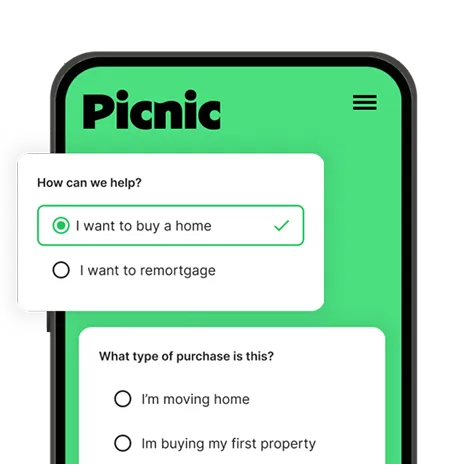Buy-to-Let Mortgage Calculator
Looking to buy a rental property? Use our buy-to-let mortgage calculator to quickly estimate your rental yield, mortgage repayments, and net monthly rental income.
Mortgage Type
With a repayment mortgage you repay all the capital and interest during the term. For interest-only, you only repay the interest amount each month and the capital is repaid in full at the end of the term.Net monthly rental income
Monthly mortgage repayment
Loan-to-value (LTV)
Interest cover ratio (ICR)
Indicates how much rental income covers mortgage repayments. Lenders typically look for an ICR of between 125%-145%.
Rental yield
Indicates the annual return on investment from the rental income expressed as a percentage of the property value.
Speak with one of our experts today to learn more about your options.
Get Started NowThis calculator provides an estimate of your monthly mortgage repayments based on the information you have entered. The figures are for illustrative purposes only, your actual payments may differ, and this does not constitute a mortgage offer.
Your home may be repossessed if you do not keep up repayments on your mortgage.

Tell Us About You
Fill out a quick 60-second form — no impact on your credit score, no endless questions.

Mortgage Match
We have access to 20,000+ products across more than 100 lenders (including exclusive deals you won’t find online) to find you the best rate and the right mortgage.

Meet Your Experts
A dedicated team handles everything. You can track your mortgage, conveyancing, and insurance progress directly from your portal.


The Mortgage Experts Trusted by Experian
Picnic is Experian’s exclusive mortgage partner, trusted to make mortgages simple. With access to 100+ lenders and expert support, we’ll help you find the right fit without the stress.
Buy-to-Let Mortgages 101
Answers to all the key buy-to-let mortgage questions for both first-time landlords and seasoned property investors.
A buy-to-let mortgage is a type of home loan you’ll need if you’re buying a property to rent out rather than live in. Unlike a residential mortgage, it’s seen as a business investment. This means lenders will need to be satisfied that the rental income you’ll earn from the property covers the mortgage repayments rather than your personal income.
This depends mainly on how much rent the property will bring in. For buy-to-let, mortgage lenders will want a clear buffer between the rental income and the mortgage payments, typically ranging from 125% to 145%.
This buffer helps provide additional protection if interest rates rise and/or during periods when the rental property is vacant. Most mortgage lenders will also require that you earn a minimum salary from your day-to-day employment (typically at least £25,000 per annum) in case you need to cover the costs when there’s no rental income coming in.
Due to the higher risks associated with rental properties, lenders tend to require a larger deposit than for residential mortgages. The standard minimum deposit for a buy-to-let mortgage is between 20% and 25%. Higher deposits will help secure the most competitive interest rates.
Most lenders will expect you to:
Be at least 21 years old (some accept 18+).
Already own your own home.
Have some previous landlord experience (or prove that you have a solid strategy if this is your first time)
Earn at least £25,000 per year from your day-to-day employment.
Have a good financial credit record.
Show that the rent will cover the mortgage comfortably (a rental income forecast can be provided by an ARLA-registered agent).
Yes, it’s possible, but it really depends on the circumstances. In the first instance, you’ll need to speak with your current mortgage lender. There are usually two options available:
Get consent to let (a short-term agreement to rent it out), or
Remortgage to a standard buy-to-let mortgage if you’re going long-term
Doing it without permission could break your mortgage agreement, so always check first.
Most landlords go for interest-only mortgages for their rental properties. That means lower monthly payments, leaving more cash in your pocket. But the debt stays the same until you sell or pay it off.
With capital repayment, you pay off a bit of the loan each month. It costs more upfront, but you’ll own a greater share of the property over time.
If you’re still unsure how to repay your buy-to-let mortgage, read our guide - Interest-only Mortgage or Repayment: Which to Choose?
Rental yield helps you work out if a property is a good investment. Here’s the formula:
Rental Yield = (Annual Rent / Property Price) × 100
So, for instance, suppose you buy a property for £200,000 and rent it out for £1,000 per month. That’s £12,000 a year. Your yield would be: (£12,000 / £200,000) × 100 = 6%.
A yield of between 5% and 8% is considered pretty good in most parts of the UK.
Yes, you can, and a holiday let mortgage is designed exactly for that: renting out a property to holidaymakers on a short-term basis while still allowing you to enjoy the place yourself now and again.
Short-term lets can bring in strong returns, especially during peak seasons. But if you’re planning to buy with a mortgage, you’ll need the right one for the job.
To find out more, read our dedicated guide on Holiday Let Mortgages.
Yes, you can. HMO mortgages are specifically designed for landlords who rent out a single property to multiple unrelated tenants, such as students or professionals sharing a house.
While the set-up can seem a bit more complex than a standard buy-to-let, the potential rental income is typically higher. So if you’re serious about boosting the returns from your property investment portfolio, an HMO Mortgage could be a smart move.